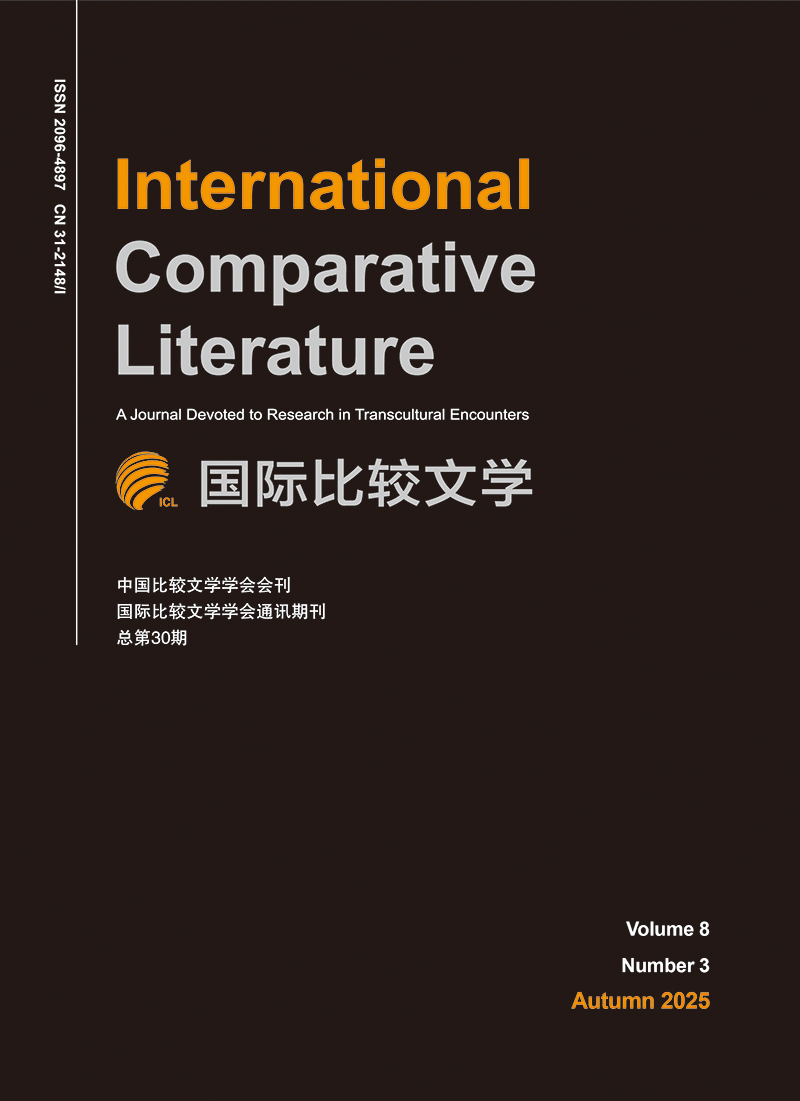|
[1]
|
(俄)巴赫金:《小说的时间形式和时空体形式:历史诗学概述》,白春仁、晓河译,《巴赫金全集(第3卷)》,石家庄:河
|
|
[2]
|
北教育出版社, 1998年。
|
|
[3]
|
[Bakhtin, Mikhail Mikhailovich.“Xiaoshuo de shijianxingshi he kongjian xingshi: lishishixue gaishu”(Forms of Time
|
|
[4]
|
and of the Chronotope in the Novel: Notes toward a Historical Poetics). Translated by BAI Chunren and XIAO He. In
|
|
[5]
|
Bahejin quanji (Complete Works of Bakhtin). Vol. 3. Shijiazhuang: Hebei Education Publishing House, 1998.]
|
|
[6]
|
(荷)巴尔:《叙述学:叙事理论导论》,谭君强译,北京:中国社会科学出版社, 2003年。
|
|
[7]
|
[Bal, Mieke. Xushuxue: xushi lilun daolun (Narratology: Introduction to the Theory of Narrative). Translated by TAN
|
|
[8]
|
Junqiang. Beijing: China Social Sciences Publishing House, 2003.]
|
|
[9]
|
(英)布莱克莫尔:《意识新探》,薛贵译,北京:外语教学与研究出版社, 2007年。
|
|
[10]
|
[Blackmore, Susan. Yishi xintan (Consciousnes: A Very Short Introduction). Translated by XUE Gui. Beijing: Foreign
|
|
[11]
|
Language Teaching and Research Press, 2007.]
|
|
[12]
|
邓波、王彦丽:《建筑空间本质的哲学反思》,《自然辩证法研究》 2004年第8期,第67—70页,第90页。
|
|
[13]
|
[DENG Bo and WANG Yanli.“Jianzhu kongjian benzhi de zhexue fansi”(Thinking about the Essence of Architecture
|
|
[14]
|
Space). Ziran bianzhengfa yanjiu (Studies in Dialectics of Nature) 8 (2004): 67-70, 90.]
|
|
[15]
|
——、罗丽:《诺伯格-舒尔茨的建筑现象学述评》,《科学技术与辩证法》2009年第2期,第54—59页。
|
|
[16]
|
[—— and LUO Li.“Nuoboge-shuerci de jianzhuxianxiangxue shuping”(Comments on Norberg-Schulz’s Architecture
|
|
[17]
|
Phenomenology). Kexuejishu yu bianzhengfa (Science Technology and Dialectics) 2 (2009): 54-59.]
|
|
[18]
|
(美)弗里德曼:《空间诗学与阿兰达蒂-洛伊的〈微物之神〉》,宁一中译,(美)费伦﹑(美)拉诺维茨主编:《当代叙
|
|
[19]
|
事理论指南》,北京:北京大学出版社, 2007年,第204—221页。
|
|
[20]
|
[Friedman, Susan Stanford.“Kongjian shixue yu alandadi-luoyi de weiwuzhishen”(Spatial Poetics and Arundhati Roy’s
|
|
[21]
|
The God of Small Things). Translated by NING Yizhong. In Dangdai xushi lilun zhinan (A Companion to Narrative
|
|
[22]
|
Theory). Edited by James Phelan and Peter J. Rabinowitz. Beijing: Peking University Press, 2007, 204-21.]
|
|
[23]
|
(美)哈维:《空间是个关键词》,《新自由主义化的空间:迈向不均地理发展理论》,王志弘译,台北:群学出版有限公
|
|
[24]
|
司, 2008年,第113—143页。
|
|
[25]
|
[Harvey, David.“Kongjian shige guanjianci”(Space as a Key Word). In Xinziyouzhuyihua de kongjian: maixiang bujun
|
|
[26]
|
dili fazhan lilun (Spaces of Neoliberalization: Towards a Theory of Uneven Geographical Development). Translated by
|
|
[27]
|
WANG Zhihong. Taibei: Qunxue Publishing Co., Ltd., 2008, 113-43.]
|
|
[28]
|
(德)海德格尔:《物》,《诗· 语言· 思》,彭富春译,北京:文化艺术出版社1991年,第146—164页。
|
|
[29]
|
[Heidegger, Martin.“Wu”(The Thing). In Shi· Yuyan· Si (Poetry, Language, Thought). Translated by PENG fuchun.
|
|
[30]
|
Beijing: Culture and Art Publishing House, 1991, 146-64.]
|
|
[31]
|
(奥)胡塞尔:《欧洲科学危机和超验现象学》,张庆熊译,上海:上海译文出版社, 1988年。
|
|
[32]
|
[Husserl, Edmund Gustav Albrecht. Ouzhou kexue weiji he chaoyan xianxiangxue (The Crisis of European Sciences and
|
|
[33]
|
Transcendental Phenomenology: An Introduction to Phenomenological Philosophy). Translated by ZHANG Qingxiong.
|
|
[34]
|
Shanghai: Shanghai Translation Publishing House, 1988.]
|
|
[35]
|
贾放:《普罗普故事学思想与维谢洛夫斯基的“历史诗学”》,《北京师范大学学报》 2000年第6期,第58—63页。
|
|
[36]
|
[JIA Fang.“Puluopu gushixue sixiang yu weixieluofusiji de‘lishishixue’(The Tale Theory of V. Propp and Historical
|
|
[37]
|
Peotics of A.Vitielovski).”Beijing shifan daxue xuebao (Journal of Beijing Normal University) 6 (2000): 58-63.]
|
|
[38]
|
(意)卡斯特拉诺:《建筑的时间性》,闵晶译,卢永毅编:《建筑理论的多维视野》,北京:中国建筑工业出版社, 2009
|
|
[39]
|
年,第261—266页。
|
|
[40]
|
[Castellano, Aldo.“Jianzhu de shijianxing”(Time in Architecture). Translated by MIN Jing. In Jianzhu lilun de duowei
|
|
[41]
|
shiye (Multidimensional Perspectives of Architectural Theory). Edited by LU Yongyi. Beijing: China Architecture and
|
|
[42]
|
Building Press, 2009, 261-66.]
|
|
[43]
|
(美)克雷斯威尔:《地方:记忆、想象与认同》,徐苔玲、王志弘译,台北:群学出版有限公司, 2006年。
|
|
[44]
|
[Cresswell, Tim. Difang: jiyi, xiangxiang yu rentong (Place: A Short Introduction). Translated by XU Tailing and WANG
|
|
[45]
|
Zhihong. Taipei: Qunxue Publishing Co., Ltd., 2006.]
|
|
[46]
|
(英)克罗克:《人文地理概论》,王志弘译,台北:巨流图书有限公司, 2006年。
|
|
[47]
|
[Cloke, Paul. Renwen dili gailun (Introducing Human Geographies). Translated by WANG Zhihong. Taibei: Juliu Books
|
|
[48]
|
Co., Ltd., 2006.]
|
|
[49]
|
(俄)柯瓦雷:《牛顿研究》,张卜天译,北京:北京大学出版社, 2003年。
|
|
[50]
|
[Koyré, Alexandre. Niudun yanjiu (Newtonian Studies). Translated by ZHANG Butian. Beijing: Peking University Press,
|
|
[51]
|
2003.]
|
|
[52]
|
林继富、王丹:《解释民俗学》,武汉:华中师范大学出版社, 2006年。
|
|
[53]
|
[LIN Jifu and WANG Dan. Jieshi minsuxue (Interpretation of Folklore). Wuhan: Central China Normal University Press,
|
|
[54]
|
2006.]
|
|
[55]
|
梁工:《圣经叙事艺术研究》,北京:商务印书馆, 2006年。
|
|
[56]
|
[LIANG Gong. Shengjing xushiyishu yanjiu (A Study of The Art of Biblical Narrative). Beijing: The Commercial Press,
|
|
[57]
|
2006.]
|
|
[58]
|
刘先觉:《现代建筑理论:建筑结合人文科学自然科学与技术科学的新成就》,北京:中国建筑工业出版社, 1999年。
|
|
[59]
|
[LIU Xianjue. Xiandai jianzhu lilun: jianzhu jiehe renwenkexue zirankexue yu jishukexue de xinchengjiu (Modern
|
|
[60]
|
Architectural Theory: New Achievements of Architecture Combining Humanities, Natural Sciences and Technological
|
|
[61]
|
Sciences). Beijing: China Construction Industry Publishing House, 1999.]
|
|
[62]
|
陆扬:《空间理论和文学空间》,《外国文学研究》 2004年第4期,第31—37页。
|
|
[63]
|
[LU Yang.“Kongjian lilun he wenxue kongjian”(Space Theory and Literary Space), Waiguo Wenxue Yanjiu (Foreign
|
|
[64]
|
Literature Studies) 4 (2004): 31-37.]
|
|
[65]
|
罗刚:《叙事学导论》,昆明:云南人民出版社, 1994年。
|
|
[66]
|
[LUO Gang. Xushixue daolun (Introduction to Narratology). Yunnan: Yunnan People’s Publishing House, 1994.]
|
|
[67]
|
(美)马格廖拉:《螽斯翼上之釉:现象学的批评》,李正治译,(美)阿特金斯、(美)莫洛编:《当代文学理论》,张双英、
|
|
[68]
|
黄景进中译主编,台北:合森文化事业有限公司, 1991年,第167—191页。
|
|
[69]
|
[Magliola, Robert R..“Zhongsi yishang zhi you: xianxiangxue de piping”(Like the Glaze on a Katydid-wing:
|
|
[70]
|
Phenomenological Criticism). Translated by LI zhengzhi. In Dangdai wenxue lilun (Contemporary Literary Theory).
|
|
[71]
|
Edited by George Douglas Atkins and Laurd Morrow. Taibei: Hesen Cultural Enterprise Co., Ltd., 1991, 167-91.]
|
|
[72]
|
——:《现象学与文学》,周宁译,沈阳:春风文艺出版社,1988年。
|
|
[73]
|
[——. Xianxiangxue yu wenxue (Phenomenology and Literature). Translated by ZHOU Ning. Shenyang: Chunfeng
|
|
[74]
|
Literature and Art Publishing House, 1988.]
|
|
[75]
|
(挪)诺伯舒兹:《场所精神:迈向建筑现象学》,施植明译,台北:田园城市文化事业有限公司, 1997年。
|
|
[76]
|
[Norberg-Schulz, Christian. Changsuo jingshen: Maixiang jianzhu xianxiangxue (Genius Loci: Towards a Phenomenology
|
|
[77]
|
of Architecture). Translated by SHI Zhiming. Taipei: Tianyuan City Cultural Enterprise Co., Ltd., 1997.]
|
|
[78]
|
——:《存在· 空间· 建筑》,尹培桐译,北京:中国建筑工业出版社,1990年。
|
|
[79]
|
[——. Cunzai· Kongjian· Jianzhu (Existence, Space and Architecture). Translated by YIN Peitong. Beijing: China
|
|
[80]
|
Construction Industry Publishing House, 1990.]
|
|
[81]
|
潘朝阳:《空间· 地方观与“大地具现”暨“经典诉说”的宗教性诠释》,《中国文哲研究通讯》 2000年第3期,第169—
|
|
[82]
|
188页。
|
|
[83]
|
[PAN Chaoyang.“Kongjian Difangguan yu‘dadi juxian’ji‘jingdian sushuo’de Zongjiaoxing Quanshi”(The Religious
|
|
[84]
|
Interpretation of Space, Local View and“Land Appearance”and“Classic Talk”). In Zhongguo wenzhe yanjiu tongxun
|
|
[85]
|
(Chinese Philosophy Research Newsletter) 3 (2000): 169-88.]
|
|
[86]
|
——:《心灵· 空间· 环境:人文主义的地理思想》,台北:五南图书出版公司, 2005年。
|
|
[87]
|
[——. Xinling· Kongjian· Huanjing: renwen zhuyi de dilisixiang (Spirit, Space and Environment: Humanistic
|
|
[88]
|
Geographical Thought). Taipei: Wunan Book Publishing Company.]
|
|
[89]
|
(美)裴特:《现代地理思想》,王志弘译,台北:群学出版有限公司, 2005年。
|
|
[90]
|
[Peet, Richard. Xiandai dili sixiang (Modern Geographical Thought). Translated by WANG Zhihong. Taipei: Qunxue
|
|
[91]
|
Publishing Co., Ltd., 2005.]
|
|
[92]
|
(英)瑞尔夫:《场所的本质》,饶祖耀﹑陈厚逸译,季铁男编:《建筑现象学导论》,台北:桂冠图书股份有限公司, 1992
|
|
[93]
|
年,第99—120页。
|
|
[94]
|
[Relph, Edward.“Changsuo de benzhi”(The Essence of Place). Translated by RAO Zuyao and CHEN Houyi. In Jianzhu
|
|
[95]
|
xianxiangxue daolun (Introduction to Architectural Phenomenology). Edited by JI Tienan. Taipei: Guiguan Book Co.,
|
|
[96]
|
Ltd., 1992, 99-120.]
|
|
[97]
|
申丹、王丽亚:《西方叙事学:经典与后经典》,北京:北京大学出版社, 2010年。
|
|
[98]
|
[SHEN Dan and WANG Liya. Xifang Xushixue: jingdian yu houjingdian (Western Narratology: Classics and PostClassics). Beijing: Peking University Press, 2010.]
|
|
[99]
|
(美)索科罗斯基:《现象学十四讲》,李维伦译,台北:心灵工坊文化事业股份有限公司, 2004年。
|
|
[100]
|
[Sokolowski,5-86.rt. Xianxiangxue shisi jiang (Introduction to Phenomenology). Translated by LI Weilun. Taipei: Xinling
|
|
[101]
|
Gongfang Cultural Enterprise Co., Ltd., 2004.]
|
|
[102]
|
谭晓冬、付鲲鹏、姚贵平:《空间的亲和:创造人性的空间》,高介华主编:《建筑与文化论集》第7卷,武汉:湖北科学
|
|
[103]
|
技术出版社, 2004年,第376—381页。
|
|
[104]
|
[TAN Xiaodong, FU Kunpeng and YAO Guiping.“Kongjian de qinhe: chuangzao renxing de kongjian”(Space Affinity:
|
|
[105]
|
Creating Human Space). In Jianzhu yu wenhua lunji (Analects of Architecture and Culture). Vol. 7. Edited by GAO
|
|
[106]
|
Jiehua. Wuhan: Hubei Science and Technology Press, 2004, 376-81.]
|
|
[107]
|
汪子嵩著:《希腊哲学史》第3卷上册,北京:人民出版社, 2003年。
|
|
[108]
|
[WANG Zisong. Xila zhexueshi (History of Greek Philosophy). Vol. 3. Beijing: People’s Publishing House, 2003.]
|
|
[109]
|
吴国盛:《希腊人的空间概念》,《哲学研究》 1992年第11期,第66—74页。
|
|
[110]
|
[WU Guosheng.“Xilaren de kongjian gainian”(Greek Spatial Concepts), Zhe xue yanjiu(Philosophical Research)
|
|
[111]
|
11(1992): 66-74.]
|
|
[112]
|
——:《希腊空间概念》,北京:中国人民出版社, 2010年。
|
|
[113]
|
[——. Xila kongjian gainian (Greek Spatial Concepts). Beijing: People’s Publishing House of China, 2010.]
|
|
[114]
|
(俄)乌斯宾斯基:《结构诗学:艺术文本的结构与结构形式的类型学》,彭甄译,北京:中国青年出版社, 2004年。
|
|
[115]
|
[Uspenskiĭ, Boris Andreevich. Jiegou shixue: yishu wenben de jiegou yu jiegouxingshi de leixingxue (A Poetics of
|
|
[116]
|
Composition: The Structure of the Artistic Text and Typology of a Compositional Form). Translated by PENG Zhen.
|
|
[117]
|
Beijing: China Youth Publishing House, 2004.]
|
|
[118]
|
(美)西蒙:《现象学与环境行为研究》,关华山编译:《民居与社会、文化》,台北:明文书局, 1989年,第143—165页。
|
|
[119]
|
[Seamon, David.“Xianxiangxue yu huanjingxingwei yanjiu”(Phenomenology and Environment-Behavior Research). In
|
|
[120]
|
Minju yu shehuiwenhua (Dwellings, Society and Culture). Translated and edited by GUAN Huashan. Taipei: Mingwen
|
|
[121]
|
Publishing House, 1989, 143-65.]
|
|
[122]
|
(奥)亚历山大:《秩序的性质:关于房屋艺术与宇宙性质》,薛求理译,《建筑师》编辑部编:《从现代向后现代的路上
|
|
[123]
|
( II)》,北京:中国建筑工业出版社, 2007年,第104—139页。
|
|
[124]
|
[Alexander, Christopher.“Zhixu de xingzhi: guanyu fangwuyishu yu yuzhouxingzhi”(The Nature of Order: An Essay
|
|
[125]
|
on the Art of Building and the Nature of the Universe). Translated by XUE Qiuli. In Cong xiandai xiang houxiandai
|
|
[126]
|
de lushang II (From Modernism to Postmodernism II). Edited by Editorial Department of Architects. Beijing: China
|
|
[127]
|
Construction Industry Publishing House, 2007, 104-39.]
|
|
[128]
|
(古希腊)亚里士多德:《物理学》,张竹明译,北京:商务印书馆, 1982年。
|
|
[129]
|
[Aristotle. Wulixue (Physics). Translated by ZHANG Zhuming. Beijing: The Commercial Press, 1982.]
|
|
[130]
|
叶涛、吴存浩:《民俗学导论》,济南:山东敎育出版社, 2002年。
|
|
[131]
|
[YE Tao and WU Cunhao. Minsuxue daolun (Introduction to Folklore). Jinan: Shandong Education Press, 2002.]
|
|
[132]
|
(波)英加登:《对文学的艺术作品的认识》,陈燕谷、晓未译,北京:中国文联出版公司, 1988年。
|
|
[133]
|
[Ingarden, Roman. Dui wenxue de yishuzuopin de renshi (The Cognition of the Literary Work of Art). Translated by CHEN
|
|
[134]
|
Yangu and XIAO Wei. Beijing: China Federation of Literature Publishing Company, 1988.]
|
|
[135]
|
(英)英伍德:《海德格尔》,刘华文译,南京:译林出版社, 2009年。
|
|
[136]
|
[Inwood, Michael. Haide geer (Heidegger: A Very Short Introduction). Translated by LIU Huawen. Nanjing: Yilin
|
|
[137]
|
Translation Publishing House, 2009.]
|
|
[138]
|
赵云:《关于笛卡尔解析几何的哲学背景》,《甘肃高师学报》 2011年第2期,第9—11页。
|
|
[139]
|
[ZHAO Yun.“Guanyu Dikaer jiexijihe de zhexue beijing”(An Analysis on Philosophical Background of Descartes
|
|
[140]
|
Analytical Geometry). Gansu gaoshi xuebao (Journal of Gansu Normal Colleges) 2 (2011): 9-11.]
|
|
[141]
|
周星:《境界与象征:桥和民俗》,上海:上海文艺出版社, 1998年。
|
|
[142]
|
[ZHOU Xing. Jingjie yu xiangzheng: qiao he minsu (Realm and Symbol: Bridge and Folklore). Shanghai: Shanghai
|
|
[143]
|
Literature and Art Publishing House, 1998.]
|
|
[144]
|
Frank, Joseph.“Spatial Form in Modern Novel.”Critiques and Essays on Modern Fiction, 1920-1951: Representing the
|
|
[145]
|
Achievement of Modern American and British Critics. Ed. John W. Aldridge. New York: Ronald Press Company, 1952.
|
|
[146]
|
43-66.
|
|
[147]
|
Gregory, Derek. The Dictionary of Human Geography. Chichester, U.K.; Malden, MA: Wiley-Blackwell, 2009.
|
|
[148]
|
Mickelsen, David.“Types of Spatial Structure in Narrative.”Spatial Form in Narrative. Eds. Jeffrey R. Smitten and Ann
|
|
[149]
|
Daghistany. Ithaca: Cornell University Press, 1981. 63-78.
|
|
[150]
|
Pearce, Lynne. Reading Dialogics. London: Edward Arnold Publisher, 1994.
|
|
[151]
|
Ricoeur, Paul.“Narrative Time.”On Narrative. Ed. W. J. Thomas Mitchell. Chicago: University of Chicago Press, 1981,
|
|
[152]
|
16
|

 点击查看大图
点击查看大图



 下载:
下载:

